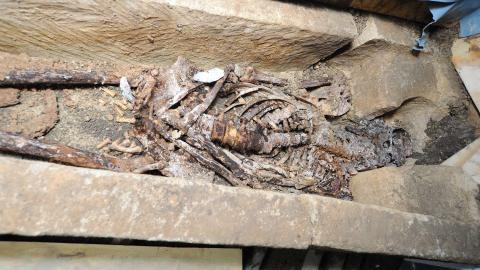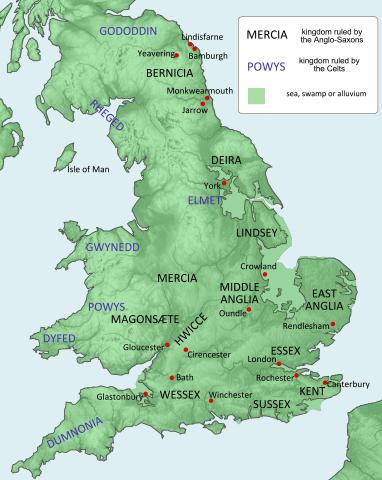< Vt Edilthryd rēgīna virgō perpetua permānserit, cuius nec corpus in monumentō corrumpī potuerit >
[1] Accēpit autem rēx Ecgfrid coniugem nōmine Aedilthrydam, fīliam Anna rēgis Orientālium Anglōrum, cuius saepius mentiōnem fēcimus, virī bene religiōsī ac per omnia mente et opere ēgregiī; quam et alter ante illum vir habuerat uxōrem, prīnceps vidēlicet Austrālium Gyruiōrum vocābulō Tondberct. [2] Sed illō post modicum temporis ex quō eam accēpit dēfūnctō, data est rēgī praefātō, cuius cōnsortiō cum XII annīs ūterētur, perpetuā tamen mānsit virginitātis integritāte glōriōsā; sīcut mihimet scīscitantī, cum hoc an ita esset quibusdam vēnisset in dubium, beātae memoriae Vilfrid episcopus referēbat, dīcēns sē testem integritātis eius esse certissimum; adeō ut Ecgfridus prōmīserit sē eī terrās ac pecūniās multās esse dōnātūrum, sī rēgīnae posset persuādēre eius ūtī cōnūbiō, quia sciēbat illam nūllum virōrum plūs illō dīligere. [3] Nec diffīdendum est nostrā etiam aetāte fierī potuisse, quod aevō praecēdente aliquotiēs factum fidēlēs historiae nārrant, dōnante ūnō eōdemque Dominō, quī sē nōbīscum usque in fīnem saeculī manēre pollicētur. [4] Nam etiam signum dīvīnī mīrāculī, quō eiusdem fēminae sepulta carō corrumpī nōn potuit, indiciō est quia virīlī contāctū incorrupta dūrāverit.
[5] Quae multum diū rēgem postulāns ut saeculī cūrās relinquere atque in monastēriō tantum vērō rēgī Chrīstō servīre permitterētur, ubi vix aliquandō impetrāvit, intrāvit monastērium Æbbæ abbātissae, quae erat amita rēgis Ecgfridī, positum in locō quem Colūdī Vrbem nōminant, acceptō vēlāmine sānctimōniālis habitūs ā praefātō antistite Vilfridō. [6] Post annum vērō ipsa facta est abbātissa in regiōne quae vocātur Elgē, ubi cōnstrūctō monastēriō, virginum Deō dēvōtārum perplūrium māter virgō et exemplīs vītae caelestis esse coepit et monitīs. [7] Dē quā ferunt quia, ex quō monastērium petiit, numquam līneīs sed sōlum lāneīs vestīmentīs ūtī voluerit; rārōque in calidīs balneīs, praeter imminentibus sollemniīs maiōribus, verbī grātiā paschae pentēcostēs epiphanīae, lavārī voluerit; et tunc novissima omnium, lōtīs prius suō suārumque ministrārum obsequiō cēterīs quae ibi essent famulīs Chrīstī; rārō praeter maiōra sollemnia vel artiōrem necessitātem plūs quam semel per diem mandūcāverit; semper, sī nōn īnfirmitās gravior prohibuisset, ex tempore mātūtīnae synaxeōs usque ad ortum diēī in ecclēsiā precibus intenta persteterit. [8] Sunt etiam quī dīcant quia per prophētīae spīritum et pestilentiam, quā ipsa esset moritūra praedīxerit et numerum quoque eōrum quī dē suō monastēriō hāc essent dē mundō rapiendī palam cūnctīs praesentibus intimāverit. [9] Rapta est autem ad Dominum in mediō suōrum post annōs septem ex quō abbātissae gradum suscēperat; et aequē ut ipsa iusserat nōn alibī quam in mediō eōrum, iuxtā ōrdinem quō trānsierat, ligneō in locellō sepulta.
[10] Cui successit in ministerium abbātissae soror eius Sexburg, quam habuerat in coniugem Earconberct rēx Cantuāriōrum. [11] Et cum sēdecim annīs esset sepulta, placuit eīdem abbātissae levārī ossa eius et in locellō novō posita in ecclēsiam trānsferrī; iussitque quōsdam ē frātribus quaerere lapidem dē quō locellum in hoc facere possent; quī ascēnsā nāvī (ipsa enim rēgiō Elge undique est aquīs ac palūdibus circumdata, neque lapidēs maiōrēs habet) vēnērunt ad cīvitātulam quandam dēsōlātam, nōn procul inde sitam, quae linguā Anglōrum Grantacaestir vocātur; et mox invēnērunt iuxtā mūrōs cīvitātis locellum dē marmore albō pulcherrimē factum, operculō quoque similis lapidis aptissimē tēctum. [12] Vnde intellegentēs ā Dominō suum iter esse prōsperātum, grātiās agentēs rettulērunt ad monastērium.
[13] Cumque corpus sacrae virginis ac spōnsae Chrīstī apertō sepulchrō esset prōlātum in lūcem, ita incorruptum inventum est ac sī eōdem diē fuisset dēfūncta sīve humō condita, sīcut et praefātus antistes Vilfrid et multī aliī quī nōvēre testantur; sed certiōrī nōtitiā medicus Cynifrid, quī et morientī illī et ēlevātae dē tumulō adfuit, quī referre erat solitus quod illa īnfirmāta habuerit tumōrem maximum sub māxillā; ‘Iussēruntque mē,’ inquit, ‘incīdere tumōrem illum ut efflueret noxius ūmor quī inerat; quod dum facerem, vidēbātur illa per bīduum aliquantō levius habēre, ita ut multī putārent quia sānārī posset ā languōre. [14] Tertiā autem dīē priōribus adgravāta dolōribus et rapta cōnfestim dē mundō, dolōrem omnem ac mortem perpetuā salūte ac vītā mūtāvit. [15] Cumque post tot annōs ēlevanda essent ossa dē sepulchrō et, extentō dēsuper pāpiliōne omnis congregātiō, hinc frātrum inde sorōrum, psallēns circumstāret, ipsa autem abbātissa intus cum paucīs ossa ēlātūra et dīlūtūra intrāsset, repente audīvimus abbātissam intus vōce clārā prōclāmāre: “Sit glōria nōminī Dominī.” Nec multō post clāmāvērunt mē intus, reserātō ōstiō pāpiliōnis, vīdīque ēlevātum dē tumulō et positum in lectulō corpus sacrae Deō virginis quasi dormientis simile. [16] Sed et discoopertō vultūs indūmentō mōnstrāvērunt mihi etiam vulnus incīsūrae, quod fēceram, cūrātum; ita ut mīrum in modum prō apertō et hiante vulnere, cum quō sepulta erat, tenuissima tunc cicātrīcis vestīgia parērent. [17] Sed et linteāmina omnia quibus involūtum erat corpus integra appāruērunt, et ita nova ut ipsō diē vidērentur castīs eius membrīs esse circumdata.’ [18] Ferunt autem quia, cum praefātō tumōre ac dolōre māxillae sīve collī premerētur, multum dēlectāta sit hōc genere īnfirmitātis, ac solita dīcere: ‘Sciō certissimē quia meritō in collō pondus languōris portō, in quō iuvenculam mē meminī supervacua moniliōrum pondera portāre; et crēdō quod ideō mē superna pietās dolōre collī voluit gravārī, ut sīc absolvar reātū supervacuae levitātis, dum mihi nunc prō aurō et margarītīs dē collō rubor tumōris ārdorque prōmineat.’ [19] Contigit autem tāctū indūmentōrum eōrundem et daemonia ab obsessīs effugāta corporibus et īnfirmitātēs aliās aliquotiēs esse cūrātās. Sed et loculum, in quō prīmō sepulta est, nōnnūllīs oculōs dolentibus salūtī fuisse perhibent; quī cum suum caput eīdem loculō adpōnentēs ōrāssent, mox dolōris sīve cālīginis incommodum ab oculīs āmovērent. [20] Lāvērunt igitur virginēs corpus, et novīs indūtum vestibus intulērunt in ecclēsiam, atque in eō quod allātum erat sarcophāgō posuērunt, ubi usque hodiē in magnā venerātiōne habētur. [21] Mīrum vērō in modum ita aptum corporī virginis sarcophagum inventum est, ac sī eī speciāliter praeparātum fuisset, et locus quoque capitis seorsum fabrēfactus ad mēnsūram capitis illīus aptissimē figūrātus appāruit.
[22] Est autem Elgē in prōvinciā Orientālium Anglōrum regiō familiārum circiter sexcentārum, in similitūdinem īnsulae vel palūdibus, ut dīximus, circumdata vel aquīs (unde et ā cōpiā anguillārum quae in eīsdem palūdibus capiuntur nōmen accēpit), ubi monastērium habēre dēsīderāvit memorāta Chrīstī famula, quoniam dē prōvinciā eōrundem Orientālium Anglōrum ipsa, ut praefātī sumus, carnis orīginem dūxerat.


